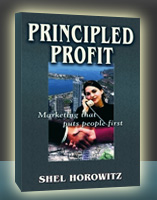Saving The World At Work
|
An excerpt from Saving The World At Work by Tim Sanders – www.SavingTheWorld.net Consider the computer company Dell. Five years ago it was standing on cracking ice. Dell had a choice to make: follow the new values (green) or suffer a painful loss. The cracking started in March 2002 with the release of a tongue-in-cheek report titled “Dude, Why Won’t They Take Back My Computer?”, prepared by the Computer TakeBack Campaign, a coalition of two dozen activist groups focused on the responsible disposal of computers. The report revealed that Dell didn’t offer American consumers the ability to recycle old computers, resulting in millions ending up in landfills every year. Computers, especially monitors, contain dangerous toxics such as lead and mercury that will eventually find their way from the landfill to the groundwater supply. This report highlighted what the EPA had been saying for years–that electronic waste was the fastest growing form of trash in the world. Widely read, it bruised Dell’s otherwise sterling reputation for social responsibility. One month later, the Texas Campaign for the Environment, a member of the Computer TakeBack campaign, issued a press release revealing that Dell ran a program in Europe where, for a fee, consumers could have their old Dell computers properly recycled. Dell provided this service because it was the law in Europe. However, in the United States, where no laws mandated computer disposal, the service wasn’t available. Executive Director for the Texas Campaign For the Environment Robin Schneider posed the question, “Why do American consumers and the American environment deserve second-class treatment?” This generated national media attention and pulled an important organization into the fray: The Calvert Group. The Calvert Group, an SRI firm, held a significant position in Dell and wanted an immediate about-face in the company’s recycling policy. Thus in May 2002, Calvert announced its intention to file a shareholder resolution at Dell’s annual meeting requiring it to conduct a study to identify its liabilities and risks from electronic waste, and then implement to a plan to address them. Shareholder resolutions are highly disruptive to annual meetings because they take the focus off future products and revenue. In 2002, Dell’s stock price was reeling from the burst of the dotcom bubble, the Enron scandal, and the terrorist attacks of September 11, 2001. The company wanted anything but a debate about how much lead or mercury was in a dead Dell. Calvert had considerable weight to throw around. According to the Austin Business Journal, it owned 17.7 percent of Dell’s outstanding shares–at the time, more than the 12 percent that Dell CEO Michael Dell himself owned. So when Calvert talked, Dell listened. After a frantic set of phone calls, Dell agreed to begin the liability study and roll out a limited program to take back computers. Calvert then withdrew the resolution. But the TakeBack campaign was dissatisfied with the out-of-meeting settlement, feeling that Dell’s promised program failed to address the real problems with its products–and charged consumers too much for recycling. Additionally, to save money, Dell’s recycling vendor, UNICOR, employed prison inmates to dismantle equipment (exempt from traditional occupational safety laws). Pulling apart computer electronics is far more dangerous for inmates than breaking rocks in the hot sun. In July, dozens of members of the Computer TakeBack Campaign showed up at Dell’s annual meeting. Outside, they held picket signs and shouted into bullhorns. Inside, taking advantage of a provision that allows any shareholder to submit questions for executives to answer, activists put Michael Dell through a grueling set of questions, and the meeting broke down into arguments and cat-calls. Still, Dell continued with its plans and hired a public relations firm to help mend its environmental reputation with a nine-city tour, during which staffers picked up computers for recycling–but without telling consumers that they would be dismantled by conscripted prison labor. In full combat mode, according to Schneider, “We threw every thing we had at them in 2003.” In January 2003, the Computer TakeBack Campaign released its annual Computer Report Card at the Consumer Electronics Show in Las Vegas. The report card measures the environmental performance of thirty computer makers. Dell not only received a failing grade, but also received a dishonorable mention because it used prison labor. Bad timing for Dell–Michael Dell was making his first keynote appearance at the conference. And it didn’t help that activists dressed as old-fashioned jailbirds protested there, posing for pictures in front of Dell’s trade show booth. Local and national newspapers ran pictures of the striped demonstrators repeatedly over the next few months. By May 2003, Dell had had its first sit-down meeting with managers from the Calvert Group, who had joined the TakeBack campaign in their support for safe working conditions for recyclers. During that same month, the TakeBack campaign targeted one of Dell’s major shareholders: Susan Dell, Michael’s wife. A dress designer with a store in a tony Austin, Texas, neighborhood, she was showing off her new line at the shop. Protesters decided to stage their own fashion show, so they gathered up some electronic waste, a glue gun, and some second hand clothes. After putting together a motley line of e-waste fashion, they walked down a makeshift runway in front of Susan’s store and handed out pamphlets educating people on the hazards of e-waste. The local fashion media picked up the story and ran a favorable review of the protesters’ sense of style rather than one of Ms. Dell’s. The gambits paid off. In July 2003, Dell announced that it would change recycling vendors to ensure occupational-safety compliance. Furthermore, Dell promised to take back any consumer’s old computer, regardless of make. Pat Nathan, Dell’s executive in charge of sustainability, publicly thanked the market campaign and the Calvert Group for their influence in getting Dell to “come around and become an advocate for social responsibility in recycling.” According to the TakeBack campaign’s Schneider, “getting an industry leader like that to change its policy in eighteen months is really quick.” Dell, which responded to intensely disruptive market pressures to protect its reputation with consumers, is a survival story. An excerpt from Saving The World At Work by Tim Sanders – www.SavingTheWorld.net |


 Shel specializes in affordable, ethical, and effective marketing for authors, publishers, small businesses, nonprofits, and community groups. Copywriter, marketing and publishing consultant, international speaker, and award-winning author of seven books.
Shel specializes in affordable, ethical, and effective marketing for authors, publishers, small businesses, nonprofits, and community groups. Copywriter, marketing and publishing consultant, international speaker, and award-winning author of seven books.